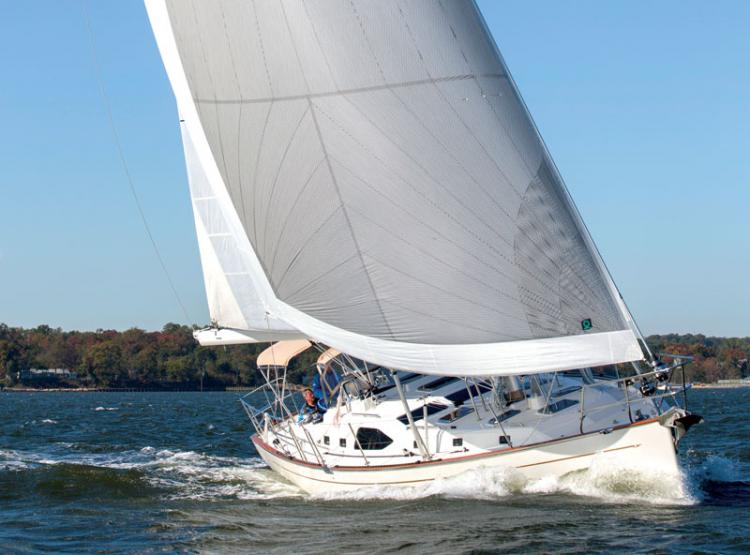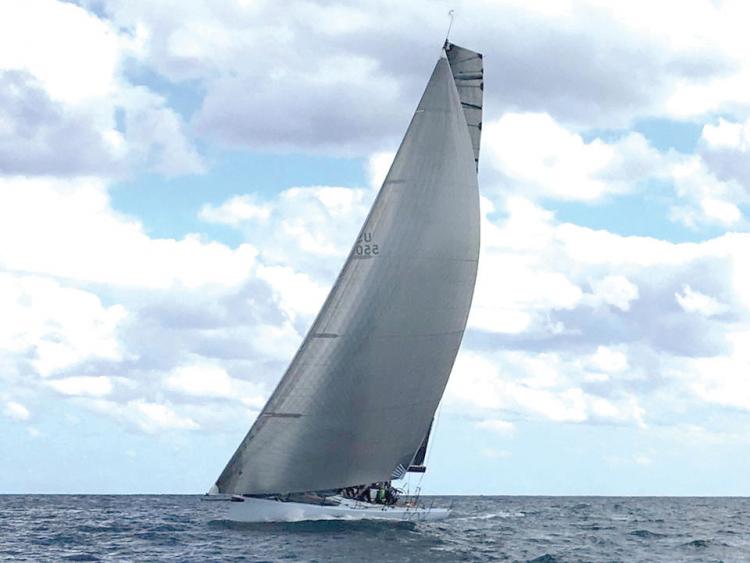An Asymmetric Spinnaker Designed to Act like a Large, Loose-Luffed Reaching Genoa
As we settle into the dog days of summer here on the Chesapeake Bay, wind is an ingredient often in short supply. We search for anything that can get us going. Fortunately the last 25 years have witnessed the development of specialty light to moderate reaching sails that are just the ticket. Often referred to as the “Code Zero,” it is essentially an asymmetric spinnaker designed to act like a large, loose-luffed reaching genoa.

These sails are particularly useful on modern racing and cruising boats which now feature non-overlapping jibs as primary headsails. Ease that non-overlapping jib out on a reach, and there is just not that much sail there to power the boat up. These usually are fractionally rigged but have spinnaker halyards that are well above the forestay or even masthead. Genoa-powered boats don’t get as much benefit since they already have a good sized reaching option.
What makes the Code Zero more useful are advances in furling technology, which can make them easier to handle, and the addition of bow sprits of various lengths that help create more space for the sail.
For racers
During the 1998-99 Whitbread Race, the term Code Zero was coined to define what was basically an upwind asymmetric spinnaker, its shape and geometry born from the limitations imposed by the class rule. Although every team had their own version by the end of the race, Paul Cayard and the winning EF Language team first realized the sail’s potential and got the lion’s share of the credit for its development.
For most syndicates the spinnaker designed for the tightest wind angles was designated as the Code 1 Reacher. Codes 2, 3, and 4 were used at progressively broader angles. Thus, Code Zero was the perfect name for a sail that could sail at closer angles than any spinnaker in the inventory. Whitbread rules didn’t allow masthead genoas but permitted masthead asymmetric spinnakers. So, naturally, creative minds wondered if it was possible to make an asymmetric spinnaker that could sail upwind, or at least nearly upwind. Asymmetrics function well at relatively high angles, but could they be pushed further?
The problem was (and is) girth. The original Whitbread rule required that the “mid-girth” be no less than 70 percent of the foot length. By comparison, a genoa has a mid-girth of 50 percent. The fundamental dilemma was that shaping was needed to support this extra area. The wider and larger a sail, the more overall camber it needs or it just flaps. Could a sail this big be made flat enough to sail at very close angles and still fly?
The first sails flapped at the back end and tended to carry large amounts of curl in the luff, but gradually the shapes were refined. While unable to attain true close-hauled angles except in the lightest conditions, the sails were still a vast improvement over a fractional jib in the same conditions.
Subsequent treatment of these sails by various handicap rules made the problem even more difficult. To prevent an “arms race” they imposed a minimum 75 percent girth restriction. Racing Code Zeros built to this limitation might get a little inside 90 degrees true wind angle, but not any closer.
There were other problems to overcome. Not only did the sail work like a genoa, but the loads were genoa-like as well. The sail challenged the strength of the entire rig. In addition, traditional nylon spinnaker materials were too elastic to allow the sail to remain flat, and it was necessary to use composites with high-modulus fibers. That made the sails difficult to douse and hard to stow.
Most of the time they ended up lashed to the deck. Specially developed furling systems eventually made them more practical, but they were difficult to furl evenly because of their girth. Often 90 percent of the sail would roll, and the remainder (the top part) would be left hanging.

For cruising sailors
For cruising sailors it has always been easier. There are no rules! You can make the sail as narrow and genoa-like or as broad and deep as you like. Even the racing rule handicappers are coming around, with many rules now allowing “tweeners” or sails between 50 to 75 percent girth if they are declared and the actual dimensions supplied.
Racing sailor or cruiser, it’s all about making the girth relative to the angles at which you want to be able to sail. For cruising applications many find a girth of 60 to 65 percent and a foot length of 140 to 165 percent is a good target. There is no free lunch. Smaller and flatter means closer angles.
For handling, the latest generation of “top down” furling systems help address the problem of getting the whole sail rolled up. Allowing the tack to spin freely and forcing the head to roll first they make getting an even, tidy roll easier and more reliable. On very narrow flat sails a standard “bottom up” system will work. Many cruising boats with Solent rigs (like Passports or new Island Packets) use a conventional furling system on the outer stay to set the Code Zero.
If the system is “free flying” (not attached to a headstay), the quality of the torsional rope is the key. If the rope twists, the furling system will not work properly. Regardless, a furled Code Zero on a cable is not designed to be left up full time. It can be left up in moderate air, but really needs to be taken down for upwind work or for windy conditions.
The only exception is the permanent standard furling system. For these, UV covers can even be added to protect the furled sail (with some compromise to sail weight).
The latest generation of furling Code Zeros is actually getting rid of the torsional rope all together. “Cable less” code zeros substitute custom fiber layouts (in one-off membrane sails) to take the place of the rope. These have the added benefit of not constraining the flying sail shape to the sag of the rope.
They actually fly better, projecting more of the luff forward and allowing the whole sail to rotate towards the direction of travel. Modern racing cableless sails are even more close winded and have less drag. You also lose the expense of the torsional cable, though the more sophisticated custom fiber layout adds to the cost. They are designed to work with top down furlers. Watch for them on cruising boats in the near future.
Bu David Flynn of Quantum Sails




